Electric wheelchairs have come a long way since their inception, evolving from basic convenience devices to sophisticated personalized mobility solutions. Let’s delve into the evolution of electric wheelchairs and the impact of innovation:
- Early Innovations: The first electric wheelchairs were introduced in the early 20th century, primarily as motorized versions of manual wheelchairs. These early models provided basic mobility assistance but lacked advanced features.
- Motor and Battery Advancements: Over the years, advancements in electric motors and battery technology led to improved performance and longer battery life. This allowed electric wheelchairs to cover greater distances and navigate various terrains.
- Customizable Seating: As technology progressed, electric wheelchairs began to incorporate customizable seating options. Users could adjust seat height, angle, and other parameters to enhance comfort and posture.
- Smart Navigation: Recent years have seen the integration of smart navigation systems using sensors and algorithms. These systems enable obstacle detection, safe navigation, and even autonomous movement in some models.
- Connectivity: Bluetooth connectivity and smartphone apps have transformed electric wheelchairs into connected devices. Users can customize settings, receive updates, and even control their wheelchair remotely.
- Voice Control: Innovations like voice control have made electric wheelchairs more accessible to individuals with limited hand function. Users can navigate and control their chairs using voice commands.
- All-Terrain Capabilities: The introduction of advanced suspension systems and large wheels has expanded the capabilities of electric wheelchairs. Users can now navigate uneven terrains, grass, and even sandy beaches.
- Foldable and Portable Designs: Foldable and portable electric wheelchairs have addressed transportation challenges. These designs allow users to easily transport their chairs in vehicles, promoting travel and mobility.
- User-Centric Design: Modern electric wheelchairs prioritize user experience. From ergonomic designs to intuitive controls, manufacturers are focusing on making the technology user-friendly and adaptable to individual needs.
- Personal Empowerment: The evolution of electric wheelchairs isn’t just about technology; it’s about empowering individuals with mobility challenges to lead fulfilling lives. These innovations enhance independence and quality of life.
As technology continues to advance, electric wheelchairs will likely become even more personalized and seamlessly integrated into users’ lives. The evolution of these mobility solutions reflects a commitment to enhancing accessibility, independence, and inclusivity.














